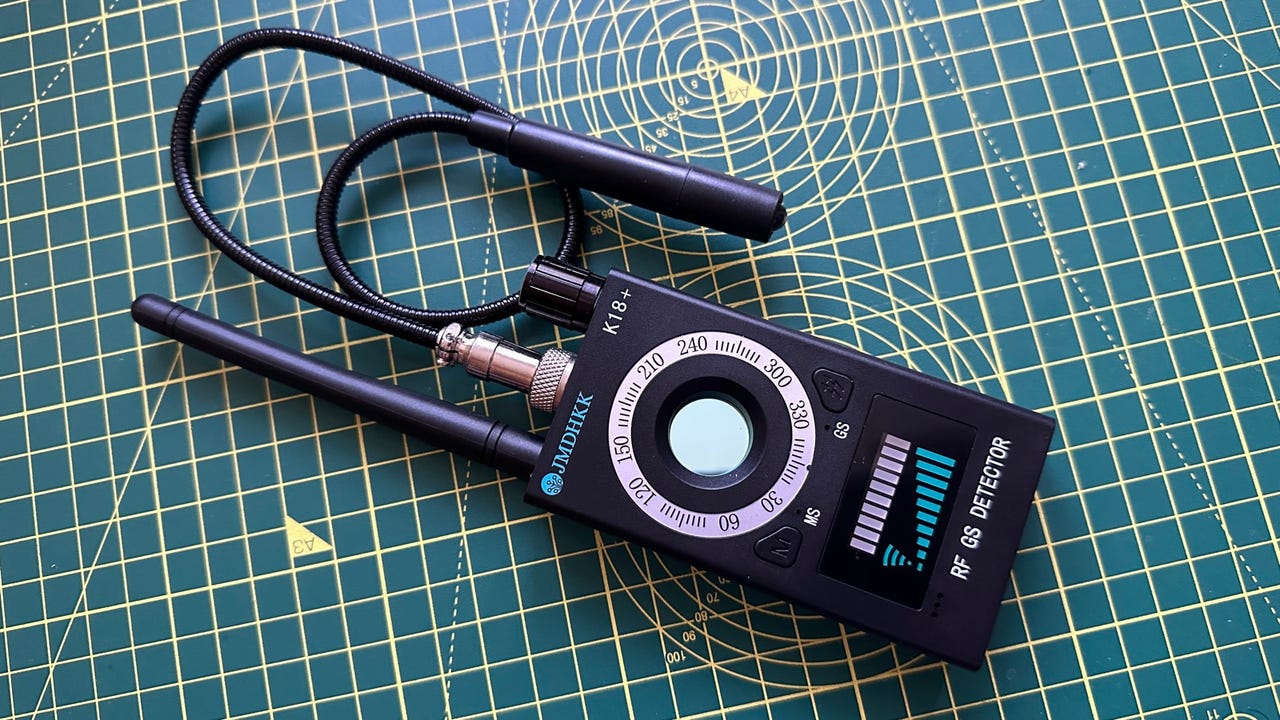
Three-in-one anti-spy camera finder and bug detector.
Adrian Kingsley-Hughes/ZDNET
As cameras and listening devices have become smaller and more affordable, there’s a growing fear that this technology could be used to spy on us and our families. This fear, stoked by high-profile news stories, has generated a market for anti-spy devices.
More recently, I’ve noticed that social media is awash with ads for these things. But do anti-spy devices work, and do you need one? The only way to answer this question is to try one out.
Also: Buy two: Tech gifts and gadgets so cool you’ll want one for yourself too
There’s lots of different anti-spy gadgets on the market, but many are the same gadget rebranded by different companies. I bought one of the most popular options I could find, which is a three-in-one camera finder, RF detector scanner, and magnetic field scanner for under $50. The aim was to see if, well, it would do anything.
This gadget claims to be able to do a lot of things. It can detect 1.2G/2.4G/5.8G wireless cameras, stealth miniature cameras, wireless audio bugs, GSM/CDMA/DECT cellular audio video bugging devices, unwanted GPS trackers, and other bug devices and bug transmitters. The specs say it can pick up RF signals in the frequency of 1MHz to to 8GHz.
The first thing I was interested in was how the camera finder works. It turns out that, along with your detector, you’re going to need your eye — because the device works by using a ring of red LEDs to shine out, and a lens you look through shows up camera lenses as bright red dots.
Here’s the ring of LEDs:
Ring of LEDs that cause camera lenses to reflect and give away their position.
Adrian Kingsley-Hughes/ZDNET
And here’s what camera lenses look like. I’ve tried it on a bunch of cameras, and it seems to work well:
This is the reflected light from a lens.
Adrian Kingsley-Hughes/ZDNET
In fact, lenses will reflect and give away their position much better than the image above can capture. From afar — and I’m talking 12 to 15 feet away — you see a red dot. As you get closer, you can see the ring of LEDs reflected in the lens.
One downside of the device is that you do need to be looking at the lens within a cone of about 15 degrees from the center of the lens to see it clearly. This issue means that if a camera lens is well hidden, you must move around a lot. But once you see that flash of red, you can investigate further.
Also: 3 security gadgets I never leave home without
The other downside of the device is that you do have to rely on your eyes, and you need to look for the cameras. There’s nothing magic or automatic about this detector. But the device works really well.
Next up, I tested the device’s ability to detect magnetic fields. This feature is sometimes referred to as a “GPS tracker detector” — and the idea here is that GPS trackers will be attached to vehicles using magnets. Again, I’ve tested this with all sorts of magnets, from super strong to fridge magnets, and it detects them.
That said, I’m not sure how useful this device would be for detecting something attached to a vehicle. There are many places to stash a transmitter on a vehicle, and the detect range of this tracker isn’t all that huge, and you do get a lot of false positives when prodding the probe into crevices.
The magnetic field detector used to find GPS trackers on vehicles works, but the range isn’t all that brilliant.
Adrian Kingsley-Hughes/ZDNET
Finally, the RF — radio frequency — detector.
I’ve tested this feature extensively with commonplace, real-world devices such as routers and smartphones, with “hidden transmitters,” and signal generators, and I’ve come away with the conclusion that it works well and has quite a decent range, but I’m not sure how useful it is.
The RF detector works as advertised.
Adrian Kingsley-Hughes/ZDNET
Unfortunately, so much around us in our everyday lives is electrically noisy. As a result, you do get a lot of false positives. If you’re aware of this issue, then you can search smart, and minimize the impact of false positives.
Also, ‘sweeping a room’ is not like it is in the movies. It’s going to take a few minutes, and you’re going to still be getting false positives from charger bricks, wiring in the walls, and a bunch of other random blips.
Also: How to find and remove spyware from your phone
Then there’s the issue that surveillance devices don’t necessarily transmit all the time. In fact, to save on power, most will either record locally or be triggered to come on.
So, the RF detector is a feature that works, but I’m not sure how useful or effective it would be.
Now, let’s come to a conclusion — do you need one of these devices?
I really don’t want to fan the flames of paranoia here. This is a solution to a very rare problem. It also takes a bit of time to become proficient in the use of this detector, and beyond the camera finder, I think the value of this tool is small.
ZDNET’s buying advice
However, the camera finder is really good, and the gadget itself is interesting and actually does what it claims to do. So with that in mind, and the fact that you can get one for $50, there’s no harm in picking up an anti-spy camera finder and bug detector.
Is it a professional counter-surveillance device? No, definitely not (if you want a pro tool, you need something like the DiscoverIt DefCon DD1206). Is this 100% guaranteed to pick up cameras and bugs? No. Is it something that might give people traveling peace of mind? Yes. Is it an interesting gadget for hobbyists or educators? Yes.




















+ There are no comments
Add yours